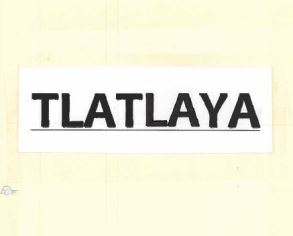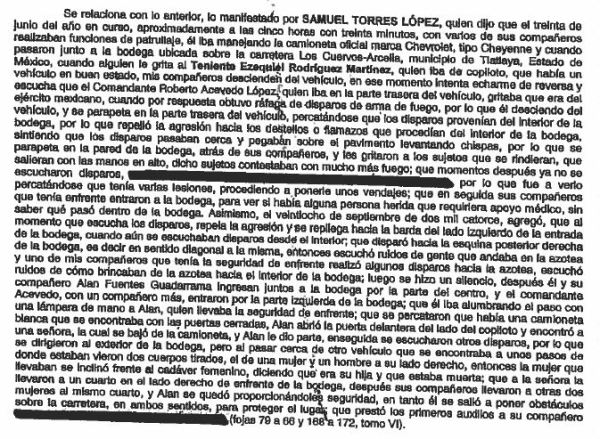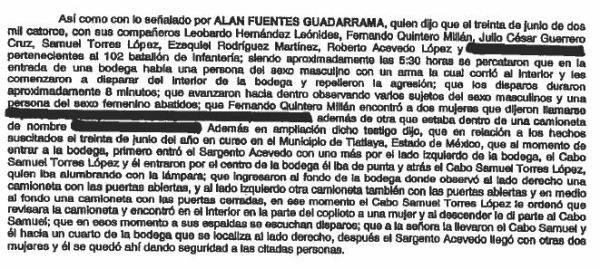Tlatlaya Revealed: Archive Petition Cracks Open Investigative File on Mexican Army Massacre
Soldiers Changed Testimony, Implicated Others in Executions
National Security Archive Appeals on Human Rights Grounds, Wins Massacre Evidence from Mexican Attorney General

Cover of the 268-page “Auto Formal de Prisión”
An access-to-information request and appeal filed by the National Security Archive for the secret investigative files on an important human rights case has produced new, more detailed, evidence about the actions of Mexican Army soldiers accused of executing at least 11 people who surrendered after a June 2014 firefight in the state of Mexico.
Released in accordance with the human rights exception in Mexico’s access law, the report on the massacre in Tlatlaya raises new questions about how Mexican authorities have handled the investigation (which is already marred by accusations of torture and cover-up), the exact number of executions that occurred that day, and why some of the soldiers later changed their testimonies to implicate others in the crime.
The newly-available report, published jointly by the Archive and the investigative team at Aristegui Noticias in Mexico, comes just days after four of the seven soldiers detained for their part in the June 30, 2014, massacre were released from custody. Three others remain behind bars, charged with murdering 11 people, some of whom were suspected members of the “Familia Michoacana” criminal group.
Bits and pieces of the testimony and reports found in the 268-page “Auto Formal de Prisión” have appeared elsewhere, most notably in the official recommendation of Mexico’s National Commission on Human Rights (CNDH), but this is the first time that the complete (albeit redacted) document has been made available to the general public. Similar to an indictment, the document includes statements from eyewitnesses and the accused, changes in testimony, and catalogs other evidence, including key passages from the medical examinations of the 22 people who were killed that day in a warehouse outside the village of San Pedro Limón.
Commissioners from Mexico’s National Institute for Access to Information and Data Protection (INAI) ordered the release of the file over the objections of the attorney general’s office, arguing, as we did in our appeal, that the Tlatlaya executions clearly constitute violations of fundamental human rights. Under Mexico’s access law, government agencies cannot withhold information pertaining to violations of human rights and international humanitarian law.
In a major victory for access to human rights information in Mexico, the INAI commissioners agreed, finding that:
… [the law] clearly recognizes the necessity that both the victims as well as society in general know the actions of the authorities in the present case, since, given its transcendent importance, these acts directly affect not only the victims and their families, but also society at large, which has been affected by the climate of insecurity generated by acts such as these and the lack of trust it fosters in institutions of transcendent national importance like the Mexican Army.
The discrepancies found between the evidence presented in the “Auto Formal de Prisión” and other official sources do little to increase trust in either the military or judicial authorities in Mexico, and raise important questions about the way the PGR has conducted its investigation and the decision this week to free four of the soldiers accused in connection to the case.
How many were executed?
As La Jornada pointed out in an article published earlier this week, there are dramatic differences in the way that evidence on the Tlatlaya case has been interpreted by CNDH on the one hand and by the office of the attorney general (PGR) on the other. The distinctions are most evident in the conclusions that each have drawn about the number of alleged gang members that were murdered after the initial firefight.
While CNDH found that the soldiers had executed “at least 15 of the [22] alleged kidnappers,” former attorney general Jesús Murillo Karam only found evidence of eight extrajudicial executions. The three soldiers who remain in custody now stand accused of killing 11 prisoners.
In another sharp divergence, both the PGR and the attorney general of the state of Mexico concluded that only five of the 22 found dead at the scene were engaged in maneuvers of instinctive self-defense in their final moments—indications that are normally associated with people being executed. In its recommendation of October 21, 2014, CNDH, the federal agency charged with guaranteeing the protection of human rights in Mexico, said that six of the dead exhibited such signs, which might include wounds to hands and forearms used instinctively to shield vital areas like the head and torso.
But an expert report from the day of the shootings found in the “Auto Formal de Prisión” indicated that as many as nine of the victims had their arms up in acts of self-defense, including victim numbers 17, 18 and 21, who were not included among those identified by CNDH or the PGR.

An expert from the office of the attorney general of the state of Mexico found that nine of the Tlatlaya victims were engaged in maneuvers of instinctive self-defense (“maniobras instintivas de defensa”) when the fatal shots were fired.
The new finding begs the question: How and why did the initial finding that nine of those killed had their arms up in self-defense get reduced to five? What impact did that conclusion have on the development of the case against the seven soldiers and the decision to release four others?
Altered testimony
The “Auto Formal de Prisión” published here today was assembled by a federal criminal court judge in November 2014 to justify the detention of seven Mexican army soldiers in relation to the massacre. Soon thereafter, the military successfully moved to have the investigation reassigned to a different court and a new judge, who later ordered that four of the accused soldiers be released, in part because PGR violated their rights. This week, that order was upheld by a higher court, and the soldiers were released (and now only face minor charges that do not justify detention).
As of today, only three soldiers from the unit allegedly responsible for the killings remain in custody; these are Sergeant Roberto Acevedo López and infantry soldiers Fernando Quintero Millán and Leobardo Hernández Leónides.
Summaries of testimony from the four soldiers who were freed this week and revealed in the “Auto Formal de Prisión” indicate that they changed their initial testimony almost three months after the fact to add what would appear to be a crucial piece of evidence: that they heard gunshots fired moments after Sgt. Acevedo, Quintero and Hernández entered the warehouse.
On September 28, 2014, five of soldiers, including Lieutenant Ezequiel Rodríguez Martínez, leader of the unit, modified their testimony, adding “that on the day and hour of the acts, after the gunshots had ceased between them and a group of armed persons, three of their companions came into the warehouse, after which they immediately hear more gunshots.”

In a revised statement, five of the soldiers present at the scene of the crime later changed their testimonies to say they heard additional gunshots after three others entered the warehouse.
Why did these five soldiers (including one who was never detained) only remember this most-critical piece of the story nearly three months after their initial statements to investigators? Today’s report from Aristegui Noticias suggests that they changed their testimony after Esquire and the Associated Press (AP) penned stories in September 2014 calling into question whether there had actually even been a shootout at the warehouse and presented evidence suggesting that there had been a number of extrajudicial executions.
The “Auto Formal de Prisión” reveals that just a week after those news stories emerged, the senior officer at the scene dramatically changed his initial testimony. Questioned on June 30, the day of the crime, Lieutenant Ezequiel Rodríguez Martínez, said nothing about hearing additional gunshots after the initial firefight. He told investigators that, after the first confrontation ended, he “ordered Sergeant Torres to support Sergeant Acevedo in an inspection of the interior of the warehouse.” He said that Acevedo discovered three people inside, presumably the three female witnesses whose horrifying accounts from that day have been detailed elsewhere.
But Rodríguez altered his testimony on September 24, just a week after the reports from Esquire and AP, when he suddenly remembered hearing an additional round of gunfire lasting several minutes from inside the warehouse. In the new version, the lieutenant said that he “ordered Second Sergeant Roberto Acevedo López and two soldiers, Fernando Quintero Millán and Leobardo Hernández Leónides”—the same three who now stand accused of homicide—“to perform an inspection of the interior of the warehouse, where they remained for between three and five minutes, reporting 22 dead.” Lt. Rodríguez “further clarified” in his revised statement “that when the gunshots had ended, about three or four minutes later, Sergeant Roberto Acevedo López, together with soldiers Fernando Quintero Millán and Leobardo Hernández Leónides, entered the warehouse, while [Rodríguez] went to check on the health of soldier Roni [another soldier who was wounded in the initial firefight] and in those moments heard more gunshots that lasted about five minutes.”
Lt. Rodríguez’s revelation about the additional gunshots received a chorus of support four days later when four of his subordinates corroborated key elements of his story that implicated the three others. Three of those who backed up the lieutenant’s story, Sgt. Torres, Julio César Guerrero Cruz, and Alan Fuentes Guadarrama, were among those released from detention this week, along with Rodríguez.
In his initial account of June 30, Sgt. Torres said he had no knowledge of what happened inside the warehouse. But on September 28, after the Esquire and AP revelations, and just four days after Rodríguez told investigators that he remembered hearing more shots, Torres recalled that he and Fuentes were inside the building assisting one of the female survivors when they heard shots fired from behind them.

In his revised testimony of September 28, Fuentes also recalled hearing shots that he had not previously remembered.

Guerrero Cruz, the squad’s radio operator who was also released this week, had little to say in his initial statement, and it’s not clear what he said in his revised testimony beyond joining the others in saying that the three soldiers now accused of homicide entered the building together and that shots were heard from inside the warehouse in the minutes that followed.
But why did the four not react at all when, by their own revised accounts, they heard an additional round of gunshots from inside the building lasting several minutes? And why did they conceal this critical bit of information during their initial interviews?
“Critical levels of impunity”
Mexico’s human rights crisis is bigger than Tlatlaya. Earlier this week, the Inter-American Commission on Human Rights found that Mexico’s legal system was crippled by “critical levels of impunity” and that “the response from the state continues to be insufficient.” Nearly every victim and advocate they spoke with complained about “obstacles that they had encountered in their search for justice and their mistrust of the authorities.” While the annual number of homicides has decreased in recent years, Mexico still faces “epidemic levels of violence,” according to the Commission. Last year, a United Nations special rapporteur on extrajudicial executions, Christof Heyns, said that between December 2006 and November 2012 Mexican authorities were responsible for 102,696 homicides, of which less than two percent resulted in condemnations. Heyns said that impunity for Mexican authorities involved in such cases was “systematic and endemic.”
With four of the accused soldiers in the Tlatlaya case now free, questions about their altered testimony and other discrepancies found in the “Auto Formal de Prisión” might seem purely academic. But beyond the lingering questions about who is responsible for the executions and apparent cover-up, Mexican society has a fundamental right to know the truth about shocking human rights crimes like the Tlatlaya executions.
___________________________
National Security Archive researcher Laura Perkins contributed to this report.

Trackbacks
Comments are closed.